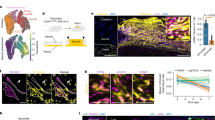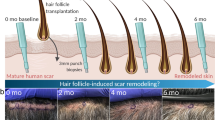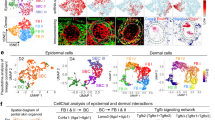Abstract
Fibroblasts are the major mesenchymal cell type in connective tissue and deposit the collagen and elastic fibres of the extracellular matrix (ECM)1. Even within a single tissue, fibroblasts exhibit considerable functional diversity, but it is not known whether this reflects the existence of a differentiation hierarchy or is a response to different environmental factors. Here we show, using transplantation assays and lineage tracing in mice, that the fibroblasts of skin connective tissue arise from two distinct lineages. One forms the upper dermis, including the dermal papilla that regulates hair growth and the arrector pili muscle, which controls piloerection. The other forms the lower dermis, including the reticular fibroblasts that synthesize the bulk of the fibrillar ECM, and the preadipocytes and adipocytes of the hypodermis. The upper lineage is required for hair follicle formation. In wounded adult skin, the initial wave of dermal repair is mediated by the lower lineage and upper dermal fibroblasts are recruited only during re-epithelialization. Epidermal β-catenin activation stimulates the expansion of the upper dermal lineage, rendering wounds permissive for hair follicle formation. Our findings explain why wounding is linked to formation of ECM-rich scar tissue that lacks hair follicles2,3,4. They also form a platform for discovering fibroblast lineages in other tissues and for examining fibroblast changes in ageing and disease.
This is a preview of subscription content, access via your institution
Access options
Subscribe to this journal
Receive 51 print issues and online access
$199.00 per year
only $3.90 per issue
Buy this article
- Purchase on Springer Link
- Instant access to full article PDF
Prices may be subject to local taxes which are calculated during checkout




Similar content being viewed by others
References
Kalluri, R. & Zeisberg, M. Fibroblasts in cancer. Nature Rev. Cancer 6, 392–401 (2006)
Gurtner, G. C., Werner, S., Barrandon, Y. & Longaker, M. T. Wound repair and regeneration. Nature 453, 314–321 (2008)
Martin, P. Wound healing–aiming for perfect skin regeneration. Science 276, 75–81 (1997)
Shah, M., Foreman, D. M. & Ferguson, M. W. Neutralising antibody to TGF-β1,2 reduces cutaneous scarring in adult rodents. J. Cell Sci. 107, 1137–1157 (1994)
Van Exan, R. J. & Hardy, M. H. The differentiation of the dermis in the laboratory mouse. Am. J. Anat. 169, 149–164 (1984)
Dulauroy, S., Di Carlo, S. E., Langa, F., Eberl, G. & Peduto, L. Lineage tracing and genetic ablation of ADAM12+ perivascular cells identify a major source of profibrotic cells during acute tissue injury. Nature Med. 18, 1262–1270 (2012)
Janson, D. G., Saintigny, G., van Adrichem, A., Mahe, C. & El Ghalbzouri, A. Different gene expression patterns in human papillary and reticular fibroblasts. J. Invest. Dermatol. 132, 2565–2572 (2012)
Collins, C. A., Kretzschmar, K. & Watt, F. M. Reprogramming adult dermis to a neonatal state through epidermal activation of β-catenin. Development 138, 5189–5199 (2011)
Jensen, K. B., Driskell, R. R. & Watt, F. M. Assaying proliferation and differentiation capacity of stem cells using disaggregated adult mouse epidermis. Nature Protocols 5, 898–911 (2010)
Festa, E. et al. Adipocyte lineage cells contribute to the skin stem cell niche to drive hair cycling. Cell 146, 761–771 (2011)
Driskell, R. R. et al. Clonal growth of dermal papilla cells in hydrogels reveals intrinsic differences between Sox2-positive and -negative cells in vitro and in vivo. J. Invest. Dermatol. 132, 1084–1093 (2012)
Lesko, M. H., Driskell, R. R., Kretzschmar, K., Goldie, S. J. & Watt, F. M. Sox2 modulates the function of two distinct cell lineages in mouse skin. Dev. Biol. 382, 15–26 (2013)
Robertson, E. J. et al. Blimp1 regulates development of the posterior forelimb, caudal pharyngeal arches, heart and sensory vibrissae in mice. Development 134, 4335–4345 (2007)
Horsley, V. et al. Blimp1 defines a progenitor population that governs cellular input to the sebaceous gland. Cell 126, 597–609 (2006)
Magnúsdóttir, E. et al. Epidermal terminal differentiation depends on B lymphocyte-induced maturation protein-1. Proc. Natl Acad. Sci. USA 104, 14988–14993 (2007)
Gomez, C. et al. The interfollicular epidermis of adult mouse tail comprises two distinct cell lineages that are differentially regulated by Wnt, Edaradd, and Lrig1. Stem Cell Reports 1, 19–27 (2013)
Page, M. E., Lombard, P., Ng, F., Gottgens, B. & Jensen, K. B. The epidermis comprises autonomous compartments maintained by distinct stem cell populations. Cell Stem Cell 13, 471–482 (2013)
Egawa, G., Osawa, M., Uemura, A., Miyachi, Y. & Nishikawa, S. Transient expression of ephrin b2 in perinatal skin is required for maintenance of keratinocyte homeostasis. J. Invest. Dermatol. 129, 2386–2395 (2009)
Schmidt, B. A. & Horsley, V. Intradermal adipocytes mediate fibroblast recruitment during skin wound healing. Development 140, 1517–1527 (2013)
Ito, M. et al. Wnt-dependent de novo hair follicle regeneration in adult mouse skin after wounding. Nature 447, 316–320 (2007)
Silva-Vargas, V. et al. β-catenin and Hedgehog signal strength can specify number and location of hair follicles in adult epidermis without recruitment of bulge stem cells. Dev. Cell 9, 121–131 (2005)
Plikus, M. V. et al. Cyclic dermal BMP signalling regulates stem cell activation during hair regeneration. Nature 451, 340–344 (2008)
Staal, F. J., Luis, T. C. & Tiemessen, M. M. WNT signalling in the immune system: WNT is spreading its wings. Nature Rev. Immunol. 8, 581–593 (2008)
Gay, D. et al. Fgf9 from dermal γδ T cells induces hair follicle neogenesis after wounding. Nature Med. 19, 916–923 (2013)
Giangreco, A., Qin, M., Pintar, J. E. & Watt, F. M. Epidermal stem cells are retained in vivo throughout skin aging. Aging Cell 7, 250–259 (2008)
Arwert, E. N. et al. Tumor formation initiated by nondividing epidermal cells via an inflammatory infiltrate. Proc. Natl Acad. Sci. USA 107, 19903–19908 (2010)
Driskell, R. R., Giangreco, A., Jensen, K. B., Mulder, K. W. & Watt, F. M. Sox2-positive dermal papilla cells specify hair follicle type in mammalian epidermis. Development 136, 2815–2823 (2009)
Rivers, L. E. et al. PDGFRA/NG2 glia generate myelinating oligodendrocytes and piriform projection neurons in adult mice. Nature Neurosci. 11, 1392–1401 (2008)
Kawamoto, S. et al. A novel reporter mouse strain that expresses enhanced green fluorescent protein upon Cre-mediated recombination. FEBS Lett. 470, 263–268 (2000)
Hamilton, T. G., Klinghoffer, R. A., Corrin, P. D. & Soriano, P. Evolutionary divergence of platelet-derived growth factor alpha receptor signaling mechanisms. Mol. Cell. Biol. 23, 4013–4025 (2003)
Acknowledgements
This work was funded by the Wellcome Trust (F.M.W., A.C.F.-S.), the Medical Research Council (MRC) (F.M.W., A.C.F.-S.) and the European Union FP7 programme: TUMIC (F.M.W.), HEALING (F.M.W.) and EpigeneSys (A.C.F.-S.). B.M.L. is the recipient of a FEBS long-term fellowship. K.K. is the recipient of a MRC PhD Studentship. The authors acknowledge financial support from the Department of Health via the National Institute for Health Research (NIHR) comprehensive Biomedical Research Centre award to Guy’s & St Thomas’ NHS Foundation Trust in partnership with King’s College London (KCL) and King’s College Hospital NHS Foundation Trust. Input from M. Mastrogiannaki, A. Reimer and B. Trappmann is gratefully acknowledged. The authors also thank J. Connelly and G. Theocharidis for providing tissue, KCL core staff, in particular J. Castle, C. Pearce and D. Cooper, for technical support, and J. Harris and the Nikon Imaging Centre at KCL for expert assistance.
Author information
Authors and Affiliations
Contributions
R.R.D. and F.M.W. designed the experiments, performed data analysis, interpreted the results and wrote the manuscript. B.M.L., E.H., K.K., A.C.F.-S., S.R.F., B.D.S. and M.C. assisted in performing and designing experiments, analysing data and interpreting results. Y.H. and G.P. generated the Dlk1-CreER transgenic mouse.
Corresponding author
Ethics declarations
Competing interests
The authors declare no competing financial interests.
Extended data figures and tables
Extended Data Figure 1 Expression of panel of markers during back skin development.
Sections were counterstained with DAPI (blue). Scale bars, 50 μm. Photomicrographs of 10-μm-thick sections are representative of three biological replicates.
Extended Data Figure 2 Expression of markers during back skin development.
a, Expression of additional markers. Counterstained with DAPI (blue). b, Co-expression of CD31, CD45, CD26, Dlk1 and Sca1. Counterstained with DAPI (blue). Scale bars, 50 μm. Photomicrographs of 10-μm-thick sections are representative of three biological replicates.
Extended Data Figure 3 Isolation and in vitro properties of dermal subpopulations.
a–c, Flow cytometry of E12.5, E14.5, E16.5 and P2 Pdgfr-α-H2B–eGFP mouse dermal cells labelled with antibodies to CD26 (a), Dlk1 (b) and Sca1 (c). Graphs show average percentage of cells that co-express individual markers and GFP. Data from three biological replicates at each time point. d–g, Clonal growth of fibroblast subpopulations from E16.5 (d, e) and P2 (f, g) dermis. d, f, Representative phase contrast and LipidTOX fluorescent images of clones encapsulated in hydrogels and cultured in DMEM plus 10% bovine serum or adipogenic differentiation medium. e, g, Quantification of lipid-positive colonies. n = 3 biological replicates. One-way ANOVA parametric tests of significance were used to determine P values: *P < 0.05; **P < 0.005; ***P < 0.0005. Error bars are ± s.e.m. Scale bars, 10 μm.
Extended Data Figure 4 Fibroblast marker expression in human skin.
a, c, e–h, Neonatal human foreskin. b, d, Adult human abdomen. a, b, PDGFR-α was detected in mesenchymal (vimentin+) cells throughout the dermis. DLK1 (c, d, f), CD26 (e, g) and PDPN (h) were differentially expressed in upper (CD26) or lower (DLK1, PDPN) neonatal dermis. DLK1 was not expressed by adult dermal fibroblasts (d). Scale bars, 50 μm. n = 2 biological replicates.
Extended Data Figure 5 Further characterization of P2 mouse dermal fibroblast subpopulations.
a, b, 10-μm sections of P2 skin stained for markers indicated, with DAPI counterstain (white). c, Flow-sorting strategy to isolate cells from P2 papillary dermis (CD26+Sca1−), reticular/hypodermis (Dlk1+/Sca1−) and hypodermis (Dlk1+Sca1+ and Dlk1−Sca1+). d, Heat map of relative messenger RNA levels of the genes indicated that are represented in histograms, summarizing data in e. e, Characterization of flow-sorted fibroblasts from P2 dermis. Relative mRNA levels of the genes indicated, normalized to Gapdh. Data are means of three biological replicates (± s.e.m.). One-way ANOVA parametric tests of significance were used to determine P values: *P < 0.05; **P < 0.005; ***P < 0.0005. f–i, Preadipocyte precursors (Lin−CD34+CD29+Sca1+) express Pdgfr-α. Single-cell suspension of P2 Pdgfr-α-H2B–eGFP mouse dermis was gated for Lin−(f), CD29+CD34+(g), Sca1+ (h) and GFP+(i). Scale bars, 50 μm. All data are representative of three biological replicates.
Extended Data Figure 6 Skin reconstitution with different fibroblast subpopulations.
a–i, See Fig. 2a for experimental set-up. a–d, Horizontal whole-mount micrographs of grafts immunostained for eGFP and LipidTOX with DAPI counterstain (blue). Boundary between dermis and hypodermis/adipocytes is indicated by dotted line. e–h, Representative macroscopic views of skin grafts. i, Number of hair follicles per graft. Error bars are ± s.e.m. n = 4 grafts per fibroblast population. One-way ANOVA parametric tests were used to determine significance. *P < 0.05. Scale bars, 100 μm (a–d) and 400 μm (e–h). j–l, Representative flow-cytometry plots from exclusion sorts of Pdgfr-α-H2B–eGFP dermis for grafting assays in Fig. 2g, k. j, Positive control: all dermal cells collected. k, No reticular/hypodermis: Dlk1+ and Sca1+ cells were not collected. l, No papillary/reticular dermal sorts: Dlk+ Sca1− and CD26+ Sca1− cells were not collected.
Extended Data Figure 7 Lineage tracing controls.
a, Dlk1-CreER and LSL-tdTomato mice were bred and at 16.5 days of gestation were injected with 5 mg ml−1 tamoxifen in corn oil. b, c, Embryos were collected at E17.5 and single-cell suspensions of labelled embryonic dermis were analysed for overlapping tdTomato expression and endogenous Dlk1 expression. b, Representative flow cytometry plot. c, Graph is representative of n = 4 embryos. Error bars are s.e.m. d–g, Blimp1 expression in embryonic and postnatal skin of wild-type (d) and Blimp1–GFP (e–g) mice. Horizontal whole mounts were stained for endogenous Blimp1 (d, f), CD26 (e) and Itga8 (g). h, i, Horizontal whole mounts of Bimp1–GFP (h) and Blimp1-Cre/LSL-GFP (i) skin co-stained for CD31. j, k, E18.5 single-cell suspensions of Blimp1–GFP (j) and Blimp1-Cre/LSL-GFP (k) cells labelled with CD26. l, Experimental approach for Lrig1-CreER labelling of papillary dermis. m, Horizontal whole-mount stain of Lrig1-CreER/LSL-tdTomato mouse skin labelled at E16.5 and collected at P2. n–p, Flow-cytometric analysis of labelling specificity of tdTomato compared to Lrig1 (n), Pdgfr-α (o) and Sca1 (p). q, Flow-cytometric analysis of overlapping expression of Lrig1–GFP with CD26. Data are representative of three biological replicates. Scale bars, 100 μm.
Extended Data Figure 8 Clonal analysis of papillary dermis.
a, Experimental strategy and flow cytometry of dermal cells isolated from mice treated with increasing concentrations of tamoxifen. b, Percentage of Pdgfr-α+ cells 4 days after treatment with different concentrations of tamoxifen (n = 7 per concentration). 25 mg g−1 tamoxifen resulted in less than 1% of fibroblasts being labelled. c, d, Whole-mount analysis of GFP-labelled cells in E16.5 skin. e, f, j, Histological analysis of the fate of papillary clones from Pdgfr-α-CreER × LSL-GFP mice injected with 25 mg g−1 tamoxifen at E12.5 and harvested at P2 (e), P10 (j) and P21 (f). g–i, Quantification of the fate of papillary fibroblast clones derived from E12.5 embryonic mesenchyme. g, Number of cells per clone. h, i, Number of cells per cross-compartmental clone of papillary and arrector pili cells (h) and pure arrector pili cells (i). n = 3 biological replicates (± s.e.m.). Scale bars, 50 μm. One-way ANOVA parametric tests were used to test for significance. ***P < 0.0005.
Extended Data Figure 9 Bone marrow transplantation, wound healing and β-catenin activation.
a–k, Bone marrow (BM) reconstitution experiments. a, Schematic representation of the experiments. Bone marrow of mice that express eGFP under the control of the CAG promoter (β-actin CMV promoter (ACP)–GFP)) or Pdgfr-α-H2B–eGFP mice was transplanted into sublethally irradiated wild-type mice. One month later, 8-mm diameter full-thickness circular wounds were made in the back skin with a biopsy punch. Skin was analysed 5 and 10 days after wounding. b, c, Y chromosome staining of reconstituted spleen from ACP–GFP (b) and Pdgfr-α-H2B–eGFP mice (c). d, e, Horizontal whole mounts of wild-type mouse back skin reconstituted with bone marrow from ACP–GFP (d) or Pdgfr-α-H2B–eGFP (e) mice, stained for GFP and Pdgfr-α with DAPI counterstain (blue). f–i, Horizontal whole mounts of wild-type mouse back skin reconstituted with bone marrow from ACP–GFP (f, h) and Pdgfr-α-H2B–eGFP (g, i) mice 5 (f, g) and 10 (h, i) days after wounding, stained for GFP and Pdgfr-α with DAPI counterstain (blue). Arrows indicate wounded regions of skin. Scale bars, 40 μm (b, c), 100 μm (d–i). j, k, Flow cytometry of GFP+ dermal cells. j, representative plots. k, Quantification of GFP+cells. ACP–GFP, n = 6 biological replicates; Pdgfr-α-H2B–eGFP, n = 5 biological replicates. One-way ANOVA parametric tests were used to test for significance. ***P < 0.0005. l–p, Fibroblast responses to wounding and epidermal β-catenin activation. l–n, Fibroblast lineages during full thickness wound repair. Pdgfr-α-CreER/LSL-tdTomato lineage tracing was performed as indicated (l) and wound beds were stained for tdTomato (green) and Lrig1 (red) (m, n). Scale bars, 150 and 50 μm. Micrographs are representative of n = 3 female biological replicates. o, p, Experimental strategy (o) and histological analysis (p) of wild-type and K14ΔNβ-cateninER transgenic mice co-stained with Itga8 (green) and Sca1 (red). n = 3 biological replicates. Scale bars, 100 μm. Number of tamoxifen (4OHT) treatments is indicated.
Extended Data Figure 10 Fibroblast lineages during full thickness wound repair.
a–d, Dlk1-CreER/LSL-tdTomato (a, b) and Blimp1/LSL-GFP (c, d) lineage tracing was performed as indicated (a, c) and wound beds were stained for PDGFRα, Itga8, Acta2, CD45 and CD31. Scale bars, 50 μm. Micrographs are representative of n = 3 female biological replicates. e–g, Quantitative analysis of single-cell suspensions of Pdgfr-α-H2B–eGFP single (control) and K14ΔNβ-cateninER/Pdgfr-α-H2B–eGFP double-transgenic mice co-stained with Lrig1-PE (e) or Itga8-APC (f) or Sca1-PE (g). n = 3 biological replicates. h, Horizontal whole mounts of control and K14bcatER skin immunstained for Lrig1 (green) and Sca1 (red). n = 6 female biological replicates. Scale bars, 100 μm. Number of tamoxifen (4OHT) treatments is indicated.
Supplementary information
Supplementary Information
This file contains Supplementary Text and additional references. (PDF 176 kb)
Rights and permissions
About this article
Cite this article
Driskell, R., Lichtenberger, B., Hoste, E. et al. Distinct fibroblast lineages determine dermal architecture in skin development and repair. Nature 504, 277–281 (2013). https://doi.org/10.1038/nature12783
Received:
Accepted:
Published:
Issue Date:
DOI: https://doi.org/10.1038/nature12783
This article is cited by
-
Evidence of steady-state fibroblast subtypes in the normal human breast as cells-of-origin for perturbed-state fibroblasts in breast cancer
Breast Cancer Research (2024)
-
Reproducible strategy for excisional skin-wound-healing studies in mice
Nature Protocols (2024)
-
Local and systemic mechanisms that control the hair follicle stem cell niche
Nature Reviews Molecular Cell Biology (2024)
-
Fibroblast diversity and plasticity in the tumor microenvironment: roles in immunity and relevant therapies
Cell Communication and Signaling (2023)
-
Preadipocytes in human granulation tissue: role in wound healing and response to macrophage polarization
Inflammation and Regeneration (2023)
Comments
By submitting a comment you agree to abide by our Terms and Community Guidelines. If you find something abusive or that does not comply with our terms or guidelines please flag it as inappropriate.



